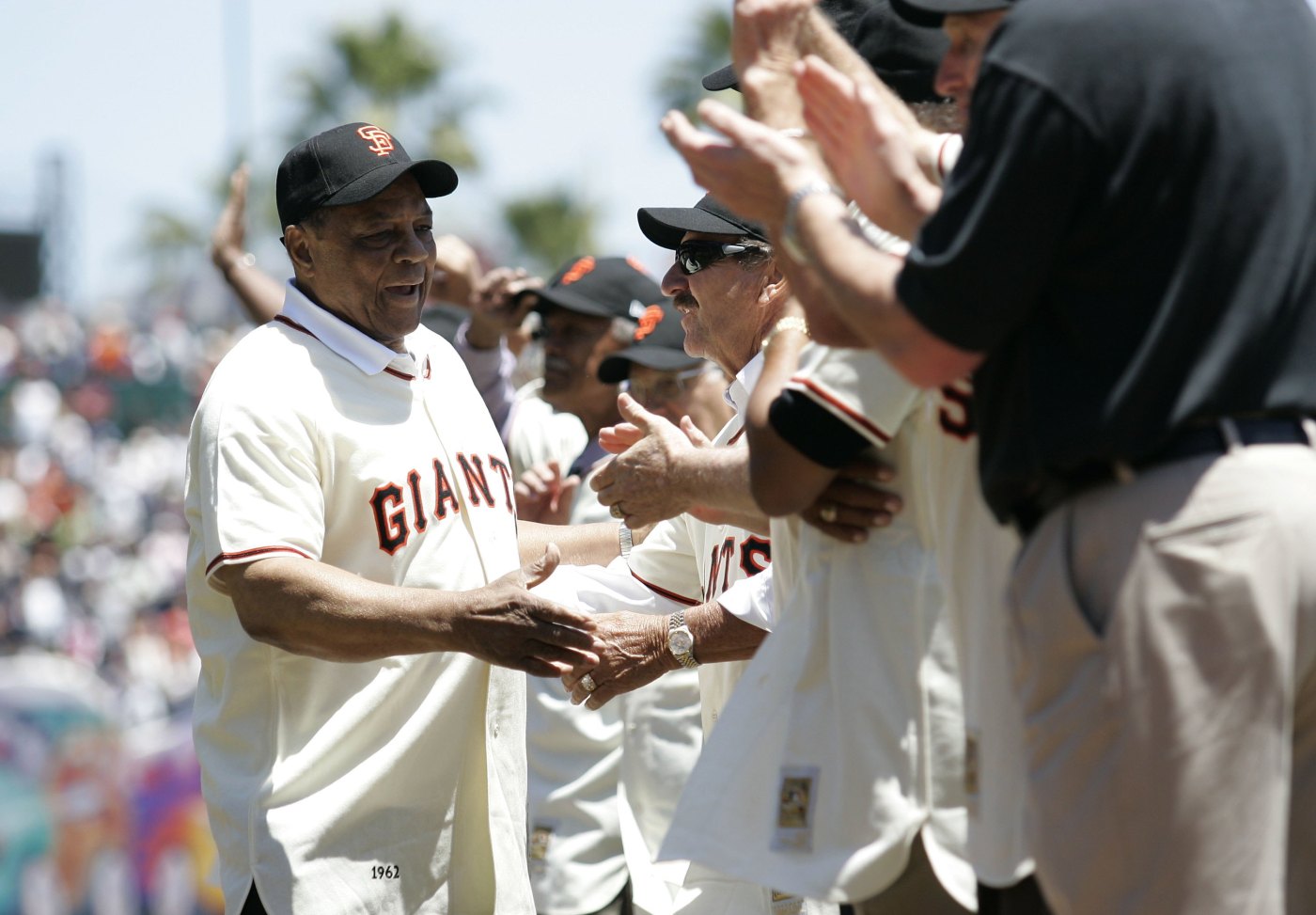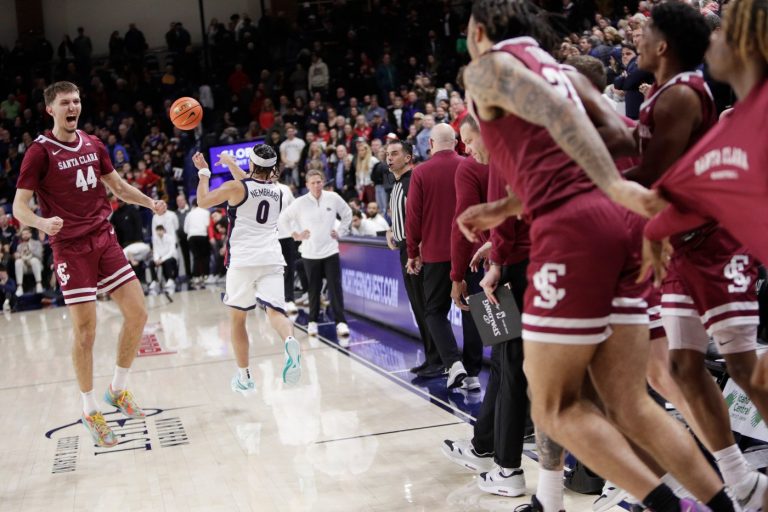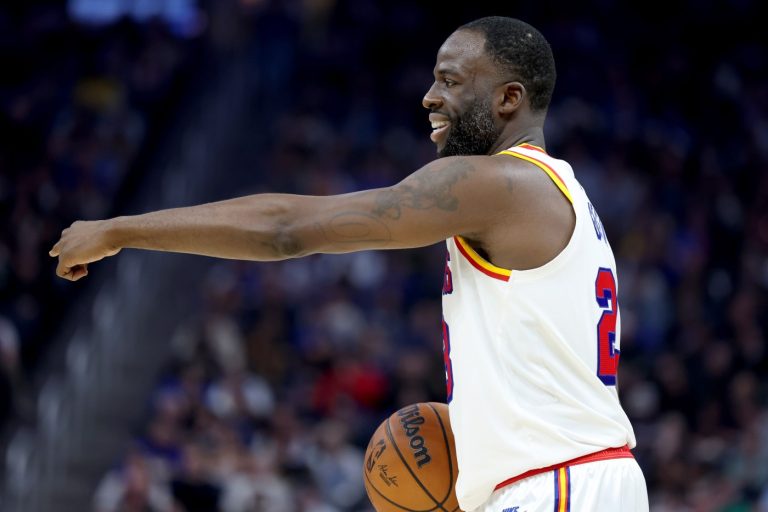Willie Mays was a teenager when he was acknowledged as a baseball phenom, a designation he quickly outgrew as if it were a pair of hand-me-down spikes.
He evolved into a first-rate ballplayer in his own right — a Negro League star, then a minor league superstar.
But it was soon apparent no superlative could hold him.
He was barely 20 years old when the Giants summoned him from their top farm team on May 25, 1951. The center fielder had caught their eye. But it was the possibility of the man that intrigued them most.
So it is that Mays, who died on Tuesday at 93 years old, is remembered — not as something so pedestrian as a slugging right-hander, a block of data on the back of a baseball card or a Hall of Famer in repose, but as an ideal.
No one combined his magnificent power, dazzling speed, supernatural arm, preternatural intuition and flair for melodrama. To say nothing of the sheer weight of his exuberance.
He was a do-it-all athlete who could hit one over the roof in the first inning, run like a deer into deepest center field to snag a howling drive in the fourth, and steal second base in an explosive cloud of dust in a tie game in the ninth.
Later Mays might charm the hard-bitten New York press with his effervescent innocence and cherubic smile, then go home to his Harlem boardinghouse and play stickball in the street with the neighborhood kids.
“If he could cook,” said Leo Durocher, Mays’ first big league manager, “I’d marry him.”
The ideal that was Mays had practical application from the get-go. He awakened the ’51 Giants, who rallied from 13 games behind to win the pennant over the Brooklyn Dodgers on Bobby Thomson’s epic home run. It was their first pennant in 14 years. Mays was voted Rookie of the Year.
He spent most of the 1952 season, and all of ’53, in the Army. When he returned to the Giants in 1954, he was voted Most Valuable Player and led them to a World Series victory. It took them 56 years to win another.
And so on, and so forth, with game-winning play after historic hit after milestone home run. But with Mays it wasn’t so much about what he did (though that was worth the price of two admissions), or the fact he played every game as if it was his first. It was more about what he might do next.
“You used to think if the score was 5-0,” Reggie Jackson once said, “he’d hit a five-run homer.”
People were drawn to the notion that a game could be played so magnificently and with such dynamism. Inevitably, anticipation trumped reality. The process became more gratifying than the result. So it happened that the most joyous ballplayer most people have ever seen spent the balance of his career, and the rest of his life, trying to live up to the preposterous expectations he inspired as the Say Hey Kid.
It wasn’t an experience to be confused with fun and games. At some point, it became more fun being a fan of the ideal than the unfortunate fellow charged with sustaining it.
That point, you could argue, came early in Mays’ career. The bittersweet truth is, things changed for Mays after the 1954 World Series. Durocher left the Giants after the ’55 season; no manager would ever again accommodate Mays so completely.
In 1958 the Giants moved to San Francisco, where fans gave younger Giants players the unconditional adoration New Yorkers had reserved for Mays. There was no stickball in the streets of San Francisco; when Mays bought a home in a white neighborhood, a brick was thrown through his front window.
The racial revolution was in full swing. Mays’ approach to conflict management was more pragmatic than militant (as when he diffused the Juan Marichal-John Roseboro brawl, cradling Roseboro’s bleeding head against his chest and leading the wounded Dodgers catcher off the field). Not all of Mays’ peers appreciated his subtlety.
“All but a few major leaguers share my view of baseball reality,” wrote Curt Flood in his book, “The Way It Is.” “Among those few who do not, the most prominent is the great Willie Mays, who reports from the privileged isolation of his huge success that he has nothing to complain about.”
Flood painted an incomplete picture. Mays acted as a buffer between the Giants’ black and Latin players and the Southern-bred insensitivity of manager Alvin Dark. He was a patriarch to a generation of minority stars, from Orlando Cepeda, to Willie McCovey, to Jim Ray Hart, to Bobby Bonds.
Competitively, Mays’ Giants failed to fulfill what many believed was their rightful destiny. They won more games than any other National League team during the 1960s, but only one pennant and no World Series. The responsibility of serving as the team’s physical and spiritual touchstone weighed heavily on Mays, who twice had to be hospitalized after collapsing during games.
“What people don’t understand is what he went through,” Dusty Baker told Salon magazine in 1999. “You’ll just never know. He played in a time when the world wasn’t as open-minded as it is now. And to this day, he’s never gotten what a Ruth or a Cobb or a Lou Gehrig have. You ever see a Willie Mays movie? Me either.”
“Mays,” it was written in Sports Illustrated shortly after his 3,000th career hit, “has had to live up to an image of ebullient heroism incurred when he was 20.”
Related Articles
SF Giants, from one generation to the next, remember Willie Mays: ‘One of the true icons of the game’
The murky origin of Willie Mays’ ‘Say Hey Kid’ nickname
Kurtenbach: There’s good, great, and then there was Willie Mays
The Catch: How Willie Mays explained his signature World Series play
Willie Mays draws tribute at Oakland Coliseum — site of his final hit
Ironically, Mays finally gained acceptance from San Francisco fans shortly before finding himself, suddenly and sadly, descending from his athletic peak. In 1972 he was traded back to New York, to the Mets, with whom he was cast in a ceremonial role. His swan song, in the 1973 World Series, is not remembered fondly.
And still the ideal lives on. Do-it-all athletes have walked among us for decades. All of them — Reggie Jackson, Bo Jackson, Magic Johnson, Wayne Gretzky, Joe Montana, Michael Jordan, Tiger Woods — follow a trail Mays blazed 70 years ago, and which remains backlit in the afterglow of his brilliance.
It would be nice to believe, at a time like this, that he felt the warmth of the comfort memories he left generations of fans. Or better yet, that he reveled in the psychic scrapbook he created for himself.
“I just felt baseball was a beautiful game,” Mays said in 1999. “Especially at night. I mean, you had all the lights out there and all you do is go out there, and you’re … by yourself in center field. It was such a beautiful game that I just wanted to play it forever, you know?”
Gary Peterson is a former reporter and columnist for the Bay Area News Group. Follow him on Twitter/X at twitter.com/garyscribe.












